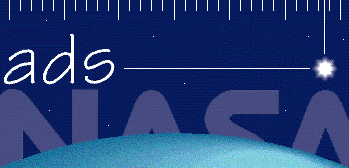
|
|
|
SAO/NASA ADS -> Help -> References and Citations Completeness |
|
| SAO/NASA ADS Help Pages |
 Prev |
Next Prev |
Next
|
3.3 - References and Citations Completeness Reference and citation lists in the ADS are not complete. There are several sources of incompleteness of citation lists: We currently get reference lists from the journals published by APS, IoP, Springer, Elsevier, and Nature as well as A&A, and MNRAS. The APS and IoP reference lists go back to volume 1 for their journals, while coverage for other journals is not complete. Another additional source of citation information is the metadata feed that we receive from CrossRef as of 2008. If you would like to submit missing citations, we do accept user-submitted citations, but ask that you follow the instructions given in our FAQ: http://doc.adsabs.harvard.edu/abs_doc/faq.html#citadd 3.4 - References and Citations From ArXiv Preprints As of March 2005, references the from arXiv preprints are integrated in the ADS. When we retrieve the metadata for the nightly update of arXiv preprints, we also process the source data to retrieve the references contained in it, either from the (La)TeX source or the PDF version of the preprints. Next, the retrieved references are parsed to resolve them into a match with an existing record in the ADS. This may not succeed for various reasons. Since there is no unformity in how the reference sections are formatted and since the coverage of journal articles outside of Astronomy and Physics in ADS is incomplete, there is always the possibility that a preprint reference section is partially or completely missing. But assuming the procedure is successfull, references found in the fulltext of a preprint are extraced, parsed, and identified as a list of ADS records. An obvious concern is whether references now contribute twice to the ADS citation lists after the associated journal article gets added to the ADS. This should not be the case, since we perform extensive matching between the preprints and published articles in order to identify them as unique records. All preprints for which we find a matching journal article with associated references will not contribute to the citation count. Whenever a (journal) article is published for which we have the preprint in our system, we will replace the preprint references with the references from the paper, if they are available. If they are not, we continue to use the references from the preprint but attribute them to the published paper. This should minimize instances of double counting of citations. However, in the case that we can not find the match accurately, we would appreciate feedback from users informing us of the match so that we can eliminate any double counting. The best way to do this is to properly update the published information for the preprint in question in the arXiv database. The ADS will then automatically be notified of the change with our daily update from them. We have given this a lot of thought and these are the main reasons why we decided to go ahead with this addition:
|
|
 Top
| Next Top
| Next
|
|